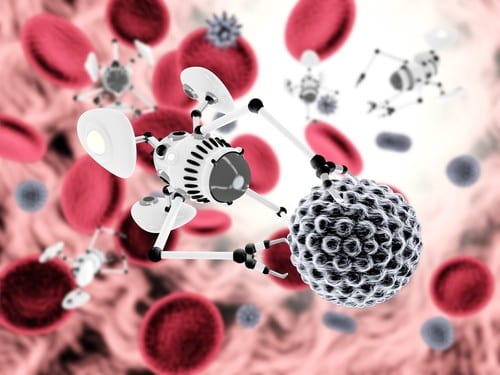From interactive, human-friendly robots, to cancer-fighting “nanorobots,” this fast-growing field has become a go-to solution in several sectors and industries. This emerging technology within the robotics and nanotechnology fields focuses on creating robots with incredibly small parts. Specifically, along the scale of a nanometer, which is one-billionth of a meter. So they’re perfect for the healthcare and medical fields, since their size allows them to navigate around the body with laser-like precision, seeking out and treating problem areas. In describing the practical application of nanotechnology to treat maladies like cancer, which have proven difficult to battle with more conventional medicine, the study appears to realize to some extent the predictions of futurists. The exceedingly tiny nanobots deployed by the researchers are not precisely the constructs one imagines when thinking of larger robots. Although chemotherapy is effective at treating cancer, it comes with some nasty side effects — including damaging healthy cells. Scientists at the Chonnam National University in South Korea may have come up with a solution: tiny, microscopic robots. Once injected into the bloodstream, they seek out and destroy cancer cells while leaving healthy cells alone. The 70-nanometer attack bots—made with two polymers and a protein that attaches to the cancerous cell’s surface—carry a piece of RNA called small-interfering RNA, which deactivates the production of a protein, starving the malign cell to death. Once it has delivered its lethal blow, the nanoparticle breaks down into tiny pieces that get eliminated by the body in the urine.
The nanorobots are essentially assassins, sent out on a mission to attack cancer at its very source. The bacteria guide the robot to the tumor and once there, it unloads its cargo of cancer-fighting drugs, contained in microscopic capsules, directly into the harmful tumor. Healthy cells are left intact. The bacteriobots have been tested in tumorous mice, which were injected with bacteriobots coated in near-infrared fluorescence and bioluminescence. Another group of mice were injected with bioluminescent bacteria that had not been attached to microbeads. The control group was injected with inert microbeads without any bacteria attached. When they were extracted, the tumours from the control group showed no sign of bioluminescence or fluorescence; the bacteria-injected group showed bioluminescence, but no fluorescence. Only the bacteriobot group showed both, indicating that the nanobots were the most effective of the three at targeting cancer cells. With this incredible new breakthrough, it is confirmed that cancer is no longer going to be a big threat to human life as it is now. The cost of implementing this procedure is still not inconspicuous though.
